The Thermo Scientific™ ARL™ SMS-2300 Robotics-Based Automation for OES or XRF is compact, quick, and simple to set up. It employs cutting-edge automation technologies to suit the demands of current metals industry laboratories. Like the recognized metals analyzers, the ARL SMS-2300 Automated Metals System is designed and maintained in compliance with ISO 9001 standards.
Thermo Scientific can completely supply and support instrument and laboratory workflow automation solutions since they designed the spectrometers that generate the analyses, which are the process’s only deliverables.
A Proven Automation Solution with Increased Performance
The ARL SMS-2300 system is the culmination of four decades of experience delivering laboratory workflow automation solutions. Over 1,000 robotized Thermo Scientific optical emission (OES) and X-Ray fluorescence (XRF) spectrometers give feedback for metals applications across the globe.
The ARL SMS-2300 system provides remarkable performance, reliability, and durability in even the most demanding metals applications. This spectrometer automation solution simplifies sample preparation and processing, allowing for shorter turnaround times.
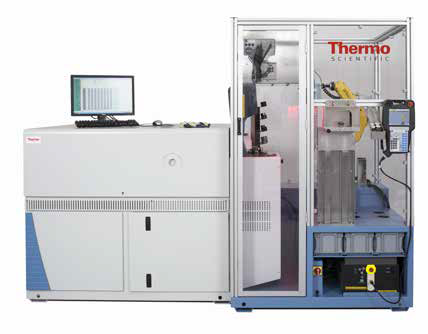
Image Credit: Thermo Fisher Scientific - Elemental Analyzers and Phase Analyzers
A Real Opportunity for the Metals Industry
Metal product specifications are getting increasingly stringent as quality requirements tighten. As a result, more than ever, the ability to do accurate analytical quality control is critical.
Manufacturing process and quality control improvements are critical in response to competitive demand for increased productivity and lower production costs. The ARL SMS-2300 system is now the greatest automation choice for increasing production quality control operations.
Increased Efficiency
The ARL SMS-2300 system enables quick and consistent sample preparation and analysis without human intervention. Costs for operations and analysis are significantly reduced.
- Faster results boost production turnover and eliminate bottlenecks
- Qualified laboratory professionals can be freed from routine responsibilities
Better Analysis Dependability and Quality
To guarantee uniformity and repeatability, all samples are handled according to predefined protocols. Removes human variables, errors, and subjective aspects that might influence the analysis outcomes. The outcomes are more precise and repeatable.
Instruments are automatically monitored to guarantee continuous control over performance. Advanced analysis methods can be challenging with a manual instrument, but they are applied consistently.
A Very Rapid Payback
Faster, more reliable, and less expensive analyses lead to a rapid return on investment. A repeatable process saves rework and downtime, improves measurement accuracy, increases productivity, and results in increased metal output.
Easy Integration into the Specific Environment
The automated ARL metals system can be utilized in both centralized laboratories and on production shop floors.
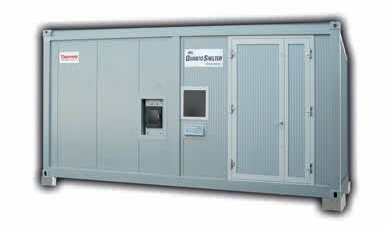
The ARL QuantoShelter Automated Metals Analyzer. Image Credit: Thermo Fisher Scientific - Elemental Analyzers and Phase Analyzers
In situ Analysis
The Thermo Scientific ARL QuantoShelter Automated Metals Analyzer is the finest choice. This automated metals system can be utilized in centralized laboratories and on production floors. It is ideal for manufacturing floor analysis. The “lab-in-a-box” container holds the whole system, including sample preparation.
The technology works similarly to a process sensor or on-stream analyzer, shortening sample transit times by bringing the laboratory to the samples rather than vice versa.
The ARL QuantoShelter Automated Metals Analyzer becomes especially appealing when production lacks shielded premises for system installation.
Laboratory Applications
It is easy to integrate automated and manual air tubes since all samples are sent into the ARL SMS-2300 system instead of the sample prep unit. Incoming samples can be temporarily stored in the SMS system and processed based on their priority, simplifying automated air tube systems.
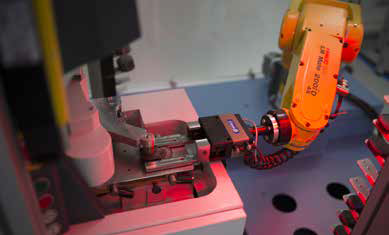
ARL SMS-2300 robot. Image Credit: Thermo Fisher Scientific - Elemental Analyzers and Phase Analyzers
Latest Robotics Technology
FANUC, the top industrial robot manufacturer in the world, produces the ARL SMS-2300 system’s robot. This medium-sized robot has six moving axes and a gripper and is installed on a chassis linked to the ARL Metals system. Its arm length is 550 mm.
Moves of up to 1.5 kg of metallic standards and samples can be performed at very high rates with a repeatability of ± 0.03 mm.
This increases lifespan and dependability by reducing wear and solicitation with average production sample weights. The robot of the ARL SMS-2300 system is powered by internal cabling and high-precision, brushless AC-Servo motors, requiring minimal maintenance.
A Powerful, Multi-Purpose, and Entirely Customizable Product
The system provides unmatched operational flexibility and capabilities for a typical product. Thanks to the customization options, users can manage a variety of applications, eliminating the need for sporadic solutions that might be challenging to maintain.
The system is easily adjustable to new or changing requirements after installation, even if they can occasionally be challenging to predict and anticipate.
High-speed and Intelligent Sample Processing
Multitasking is fundamental to the automated ARL Metals Analyzer’s design to reduce sample turnaround times.
The system's three components—the preparation machine, SMS system, and spectrometer—all function independently and simultaneously.
Samples are being prepared as more are being provided or examined. The ARL automation workstation, the “brain” of the system, methodically improves sample turnaround times.
The ARL SMS-2300 system’s robot is not needed as the spectrometer concurrently cleans electrodes and modifies the instrument stand. When the instrument is busy, the preparation machine automatically uses the waiting positions for prepared samples to free it up to handle the next sample.
Top Class Performance and Uptime
Easy Sample Registration and Introduction
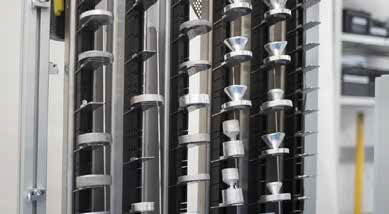
Temporary storage of incoming samples. Image Credit: Thermo Fisher Scientific - Elemental Analyzers and Phase Analyzers
The introduction and registration of samples can be facilitated in several ways. Manual registration of manufacturing samples is feasible. Registering online using other computers, such as process computers or laboratory management systems, is another option to save time and avoid errors.
The ARL SMS-2300 system does not require electromechanical sample introduction magazines or transfer systems since it always introduces samples directly before preparing them.
To accommodate high cadences, the robot can temporarily store incoming samples in a fixed, random-access magazine.
These samples are automatically handled in accordance with their distinct priorities rather than being processed in the order that they arrive. In monitoring, the production samples that are awaiting processing are displayed.
Open Architecture for Sample Preparation
For system uptime and analytical performance, an automated metals analyzer must be able to produce samples of the greatest quality, consistency, and reliability. The last few years have seen a major shift in sample preparation, with milling being the preferred technique for applications using metals.
Understanding that consumers want alternatives when it comes to brands and solutions, Thermo Scientific offers a wide range of sample preparation options. Customers can select the best solution according to their needs, preferences, and budgetary limitations.
Tightly Integrated Sample Preparation
The ARL SMS-2300 system’s robot has direct access to most sample preparation machines for loading and unloading. This reduces sample turnaround times and eliminates unnecessary hardware.
The system requires limited floor area and short distances between components, allowing for rapid operation while maintaining accessibility for maintenance. This enables simple access to the sample preparation equipment for maintenance or semiautomatic operations without having to switch off the robotic system.
More Reliable, Accurate, and Reproducible Analyses
The global system’s reliability is similar to a line’s weakest link. The automatic system’s components are carefully chosen based on stringent quality standards, and the SMS software is thoroughly tested before its implementation.
- The system's key component is the ARL iSpark, equipped with its own PC and OXSAS analysis software. The SMS robot rapidly clamps the prepared sample onto the spectrometer platform. The sample is automatically clamped on the stand table during the measurement procedure.
- The ARL SMS-2300 system’s robot accurately transfers samples between sparks.
- Bad sparks are immediately discarded. Bad burns can be detected early in the pre-integration phase, minimizing processing times for tough samples.
- The stand table and the electrode are cleaned automatically in hidden time
- The robot grasps and handles each production, setup, control sample, and type standard as a separate sample to provide the maximum degree of sample manipulation reliability
Samples are sorted and kept in containers following analysis, and the results of the analysis are automatically conveyed. Samples that cannot be analyzed can still be manually examined by filing them chronologically on a chute.
Sample Surface Management
The analysis surface of each standard is designed to conduct as many sparks as feasible without the need for re-preparation. This saves money on reference samples while freeing up time to process production samples. The user sets the spark positions for each sample and standard.
Automation to Advance Quality Control Capabilities
Instrument Performance Monitoring
It is critical that the automated metals analyzer consistently generates high-quality results to reduce waste and rework during manufacturing.
Statistical process control, or SPC, is the routine examination and processing of control samples to detect anomalies. When needed, the system begins automated instrument standardization, and alarms are issued when manual actions are required to keep the system from losing control.
The analytical performance of the instrument can be recorded and shown in control charts (SPC-Full option) for certification without operator participation. These SPC tools can be automatically deployed during the manufacturing process to swiftly assess product quality and indicate potential adjustments.
Type standards are provided to overcome inconsistencies in response between alloy composition and instrument calibration.
Conditioning samples could be inspected to remove any possible stand contamination when trace elements need to be evaluated after alloy samples.
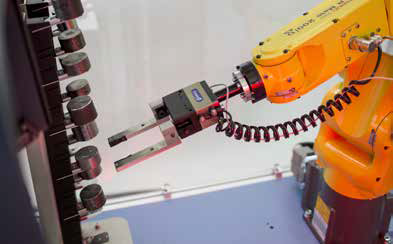
ARL SMS-2300 Setting-up Samples, Control samples, and Type standardization sample. Image Credit: Thermo Fisher Scientific - Elemental Analyzers and Phase Analyzers
The ARL SMS-2300 magazine, a fixed and universal device, is used for type standards, control samples, and setup. It can hold up to 11 standards of different diameters (147 standards are an option). At an operator's request, these standards are automatically updated just before analysis or during downtime.
The SMS robot automatically rotates the standards by about 30° in advance to reduce sample inclination difficulties and bias in replacement over time.
Full Compliance with Safety Regulations and Audit Trail
The safety enclosure of the ARL SMS-2300 Automated Metals system was built following CE certification norms. Additionally, the system complies with electromagnetic norms and requirements, as well as robotics applications.
In addition to assigning system resources, user accounts protect the system from unauthorized modifications.
Events of interest can be stored on disk and shared with other computers to ensure the traceability of quality control procedures.
Three superimposed color lights (red, blue, and green) permanently display the system status (optional).
Digital signals are optional to notify external user-supplied equipment (such as lighting and sound devices) about specific occurrences.
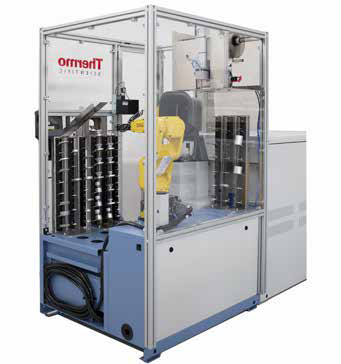
Safety enclosure with access doors. Image Credit: Thermo Fisher Scientific - Elemental Analyzers and Phase Analyzers